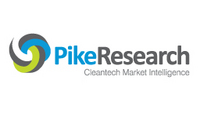Early Fuel Cell Activity is Creating New Markets for Hydrogen, According to Pike Research
 |
BOULDER, Colo.--While hydrogen is widely used for its chemical properties in a range of industrial applications, its use as a fuel is still a niche market. To date the largest demand for hydrogen as a fuel has come from the United States space program. Now, however, fuel cells that use direct hydrogen are opening up new markets for hydrogen suppliers -- ones with potentially high demand if some key applications take off. Those key applications include light duty vehicles, forklifts, buses, stationary power, and scooters. According to a new report from Pike Research, projected demand for hydrogen as a fuel will be around 107 million kilograms (kg) through 2015, with annual demand reaching 418 million kg in 2020. While forklifts and backup power applications will drive demand in the first half of the decade, light-duty fuel cell vehicles will create significant new demand starting 2015, the cleantech market intelligence firm finds.
“These different fuel cell markets present different infrastructure buildout pathways, with varying opportunities and challenges. Stationary fuel cells, for example, offer a very different infrastructure story than vehicles.”
"Fuel cells are actually being put into service in large numbers today, and it's not only about the cars," says senior analyst Lisa Jerram. "These different fuel cell markets present different infrastructure buildout pathways, with varying opportunities and challenges. Stationary fuel cells, for example, offer a very different infrastructure story than vehicles."
Pike Research's analysis indicates that forklifts will be the largest driver of hydrogen fuel demand by 2020, representing 36% of the total market by that time. The other large application categories include light duty vehicles, which will consume 33% of total hydrogen, and uninterruptible power supplies (UPS) for stationary power, which will represent 27% of the total. Fuel cell buses and scooters will each be a relatively small percentage of total hydrogen demand.
Significant players in the emerging market for hydrogen fueling include industrial gas companies (IGCs), large energy and gas companies, and other hydrogen infrastructure providers such as electrolyzer companies that are already supplying the merchant hydrogen market. IGCs, in particular, see fuel cell forklifts as a promising new market, and these industrial suppliers are already familiar with indoor hydrogen use. Pike Research further forecasts that, by the end of the decade, annual investment in hydrogen stations will reach $1.6 billion, with a cumulative 10-year investment totaling $8.4 billion.
As a result of this infrastructure investment, more than 5,200 hydrogen fueling stations for cars, buses, and forklifts will be operational worldwide by 2020, up from just 200 stations in 2010.
Pike Research's report, "Hydrogen Infrastructure", analyzes the dynamics of global demand for hydrogen fuel and the infrastructure investments that will support fueling stations for fuel cell light duty vehicles, buses, forklifts, scooters, and stationary power applications. The study includes an examination of market issues, technology issues, and the competitive landscape within the hydrogen infrastructure industry. Market forecasts for hydrogen demand and fueling infrastructure, segmented by application and geography, are provided through 2020. An Executive Summary of the report is available for free download on the firm's website.
Pike Research is a market research and consulting firm that provides in-depth analysis of global clean technology markets. The company's research methodology combines supply-side industry analysis, end-user primary research and demand assessment, and deep examination of technology trends to provide a comprehensive view of the Smart Energy, Smart Grid, Smart Transportation, Smart Industry, and Smart Buildings sectors.


